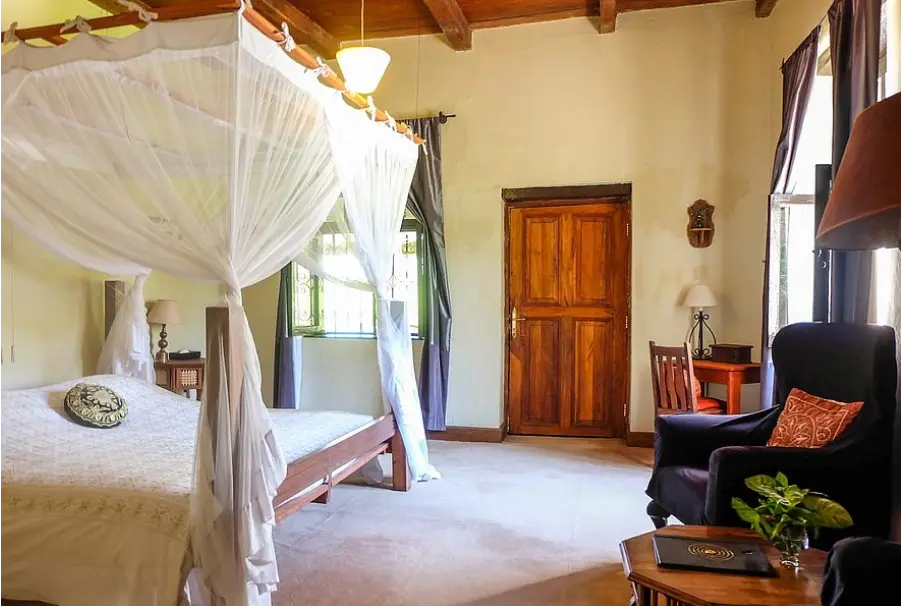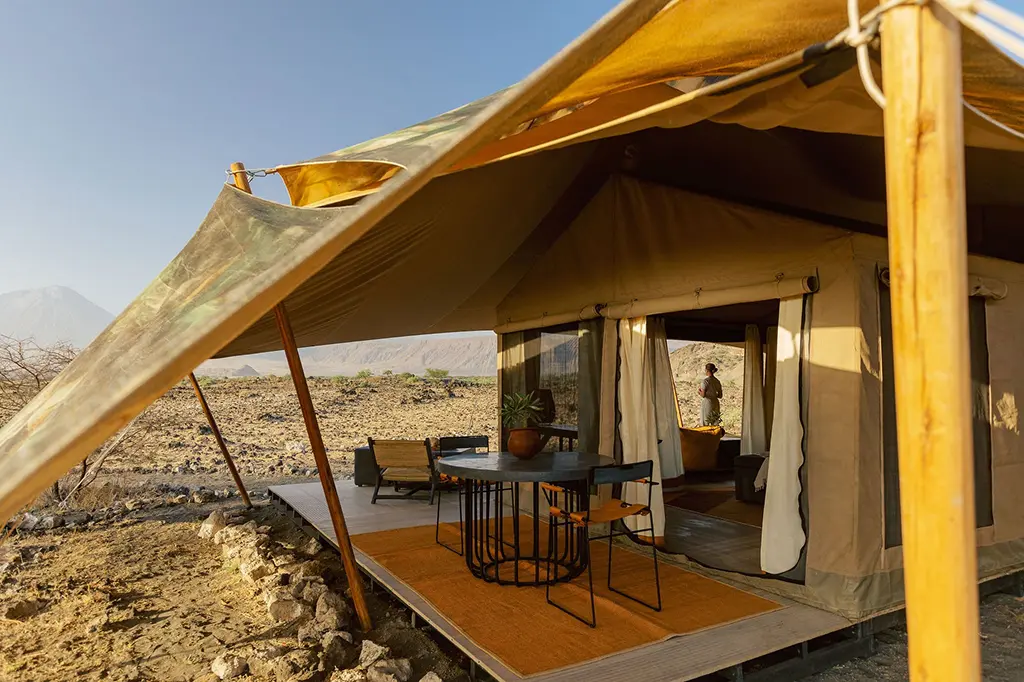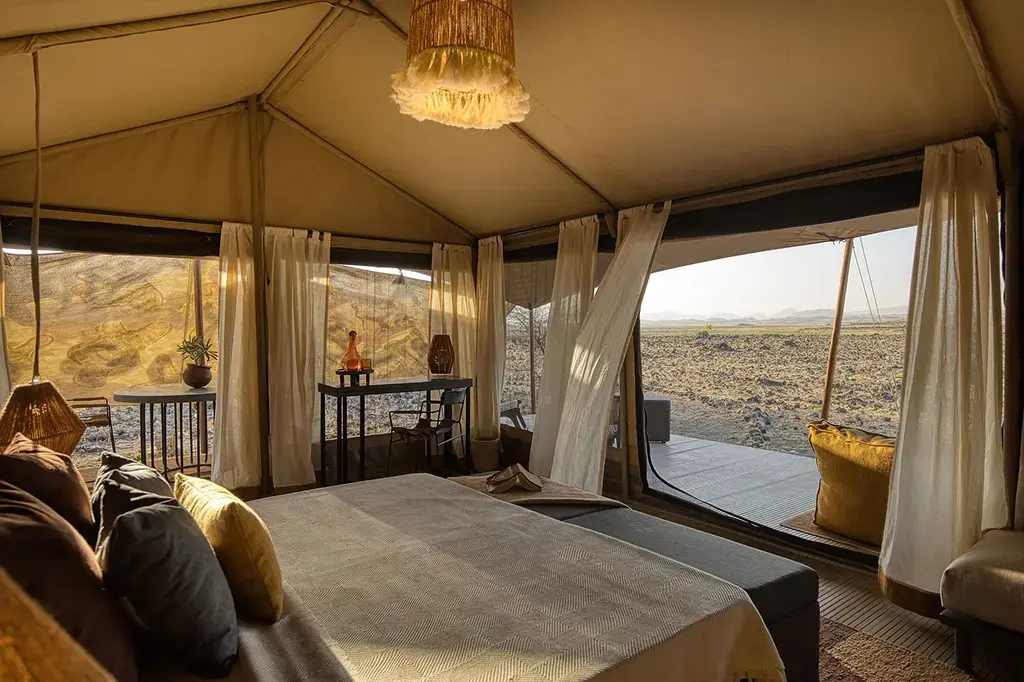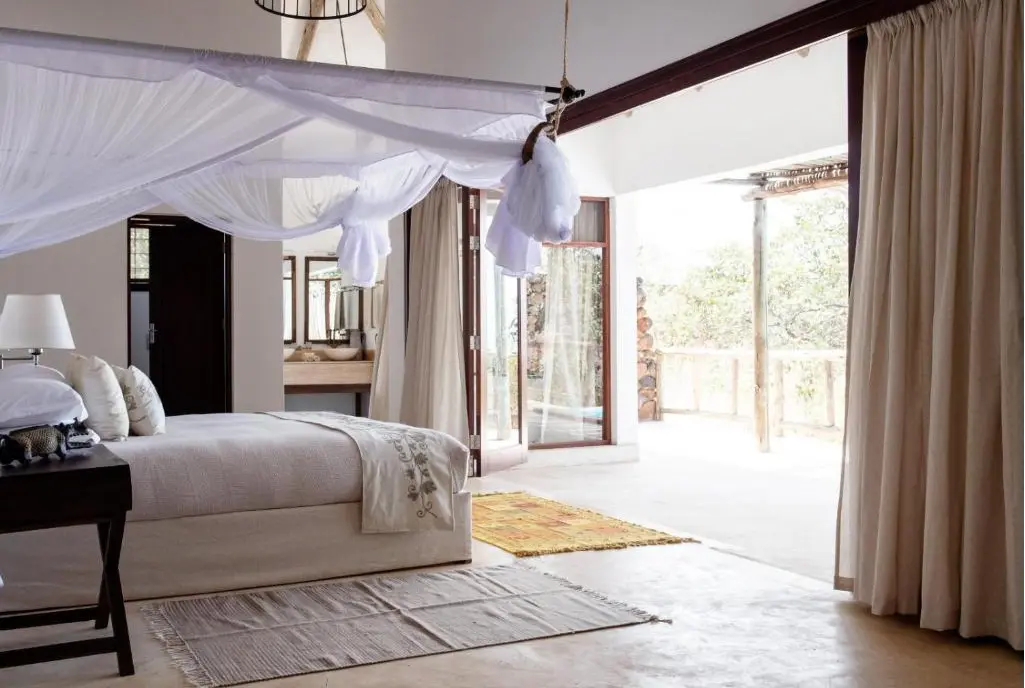
Lake Natron & Ngorongoro Safari and Cultural Visit to Mto wa Mbu Village
Lake Natron & Ngorongoro Safari and Cultural Visit to Mto wa Mbu Village
This 4-day itinerary takes you deep into two of the Great Rift Valley’s most extraordinary landscapes. First stop: Lake Natron — two nights in this rarely-visited, wild, remote, and otherworldly landscape. Flamingos nest nearby, zebra trot past your tent, and the active Ol Doinyo Lengai volcano looms in the distance.
Next, you'll enjoy a trip to the Mto wa Mbu village - a great chance to learn about local life and culture before diving back into the wild, followed by overnight at a scenic lodge overlooking the Lake Manyara escarpment.
Your final stop is the Ngorongoro Crater, a UNESCO World Heritage Site and a home to Africa’s densest population of wildlife, including lions, elephants, and even rhinos.
This is the perfect trip if you want to combine raw nature, cultural encounters, and world-class game viewing — all without rushing between too many locations.
Safari Tour Price
 Lake Natron & Ngorongoro Safari
Price per person
Lake Natron & Ngorongoro Safari
Price per person
 Lake Natron & Ngorongoro Safari
Price per person
Lake Natron & Ngorongoro Safari
Price per person
Safari Itinerary
The group arrives at Kilimanjaro Airport (JRO). Participants are met by a representative of Altezza Travel and transferred to a hotel in Arusha.
Note: Check-in starts at 2:00 PM.


Located on the slopes of Mount Meru, Ngare Sero Mountain Lodge is perfectly suited for exploring the natural beauty of East Africa. The main house is one of the oldest family cottages in Arusha: it was built at the beginning of the 20th century and still retains many features of the original style. Kilimanjaro International Airport is just 27 kilometers (17 miles) away, making the lodge an excellent place for overnight stays between climbing and safaris.
A respectful attitude towards historical heritage is combined at Ngare Sero Mountain Lodge with modern standards of comfort and hospitality. Each room features comfortable wide beds with carved headboards and anti-mosquito canopies, large baths to relax in after a busy day on safari, solid wood furniture, lamps, sockets, Wi-Fi, and everything needed for rest and relaxation.
Long verandas in colonial style stretch along the facade of the house. Sitting in chairs with long armrests, it's pleasant to admire the lake, greenery, and gardens. And when the clouds dissipate, one can see the majestic Mount Kilimanjaro.
The property has an outdoor pool with sun loungers and a spa center where guests can book a massage session or other self-care treatments. There is also a bar and restaurant. Breakfast, lunch, and dinner can be enjoyed in the dining room with an open veranda, in the dining area, or in a secluded pavilion by the lake.

This day will take place at Lake Natron, a very beautiful and remote place. Often featured in wildlife magazines, Natron is the only place in the world that has red-hued water. The color is attributed to a high content of special bacteria, which have a blood-red color. However, it can only be seen and photographed from a bird's-eye view. Lake Natron has very beautiful African landscapes and wild animals: ostriches, antelopes, zebras, giraffes also live here, but due to its remote nature, there are not many tourists. This is a great place to start or end your safari through Tanzania's northern parks.
It can be quite hot during the day. To freshen up, you can swim in the springs nearby. Water flows into them directly from the slopes of the Ngorongoro Reserve. It is very pure and well-saturated with sulfur. Some scientists believe it is beneficial for the development of bones in the body. We're not sure about that, but it's definitely not harmful.
Several authentic African tribes live around the lake, including the famous Maasai. You may visit their settlements and see their way of life.


Lake Natron Camp boasts a unique location near Lake Natron, one of the most mysterious and attractive places in Africa. This camp comprises ten luxury guest tents with everything you need for a comfortable stay. Among the activities available in the region and offered by this camp are a guided walk to Lake Natron, an ascent of the volcano Ol Doinho-Lengai, a walk to the Engare Sero waterfall, and a visit to the famous Maasai tribe. A natural pool near the lounge is furnished with a wooden deck and chairs to relax after plunging into the pool.
This location is perfect for August-October when thousands of flamingos migrate here for hatching - you can catch the most precious moments of these birds' life taking a walk to the alkaline lake shores that would take only 5 minutes from your tent! Zebras and wildebeests love to wander right across the camp area, so you can freely watch them from your lounge.

Very beautiful birds live on Lake Natron including large and small flamingos, which can have numbers of tens of thousands at a time! The brilliant pink birds taking flight is a very beautiful sight. Flamingos are very fond of Lake Natron, because here they are guaranteed not to be disturbed by predators because of the water’s high alkaline level. Every year from September through to April, more than three-quarters of all Lesser Flamingos in the world are born on Lake Natron. Eggs are laid in the shallow mud of the waters, and new chicks hatch along the shore. Through binoculars, you can watch very small chicks that are just taking their first steps. They are still gray in color, but very soon their plumage will begin to turn pink.
In addition to flamingos, pelicans and other birds are found in the vicinity of Lake Natron. In the wild, they behave completely differently from the zoo - the birds are very active and playful.


Lake Natron Camp boasts a unique location near Lake Natron, one of the most mysterious and attractive places in Africa. This camp comprises ten luxury guest tents with everything you need for a comfortable stay. Among the activities available in the region and offered by this camp are a guided walk to Lake Natron, an ascent of the volcano Ol Doinho-Lengai, a walk to the Engare Sero waterfall, and a visit to the famous Maasai tribe. A natural pool near the lounge is furnished with a wooden deck and chairs to relax after plunging into the pool.
This location is perfect for August-October when thousands of flamingos migrate here for hatching - you can catch the most precious moments of these birds' life taking a walk to the alkaline lake shores that would take only 5 minutes from your tent! Zebras and wildebeests love to wander right across the camp area, so you can freely watch them from your lounge.

After a scenic 4-hour drive from Lake Natron, you’ll arrive in the vibrant village of Mto wa Mbu — a lively stop nestled at the base of the Great Rift Valley escarpment. First, you’ll enjoy a delicious local lunch prepared by a welcoming host family. Served outdoors in a tidy, shaded spot, the meal includes Swahili favorites like vegetable stews, ugali, rice, sautéed greens, okra, and chapati flatbreads. The menu varies depending on seasonal ingredients, and dietary needs can be accommodated — just let your travel manager know in advance!
Once you’ve recharged, it’s time to explore. Mto wa Mbu is home to around 18,000 people and more than 120 tribes — a true cultural mosaic. You’ll visit traditional homes, browse the bustling market, and get a peek into daily life: from farming and cooking to woodcarving and painting. At the banana plantation, your guide will introduce you to the many uses of this versatile plant — from food to building materials. Local artists and craftsmen will share their techniques and the stories behind their work.
To wrap up your visit, don’t miss the chance to try mbege — a traditional banana and millet beer, brewed right here in the village. It’s the perfect finish to a rich and flavorful cultural encounter.



Today you are going to the Legendary Ngorongoro Crater! Your day will begin early in the morning, when your guide arrives to drive you to the Ngorongoro Crater, part of the Ngorongoro Conservation Area. The Crater is somewhat reminiscent of The Lost World by Sir Arthur Conan Doyle: here you will witness tens of thousands of wild animals living in the massive crater left by a huge ancient volcano. The actual crater is relatively small, when you consider that it is home to the most variety of animals per square meter than anywhere else in the world! Here, you are sure to see a great number of animals within close proximity to one another.
The descent into the crater will take about half an hour of driving. The road passes through beautiful, lush forests with great scenery. Your safari guide will make a stop to see the ‘look out’ which is a place offering a stunning panoramic view of the entire crater. Contrary to popular myth, animals can go outside the caldera. However, most of them are safe and comfortable inside the caldera which provides an unlimited supply of fresh grass for grazers and easy prey for predators. Therefore, they prefer to remain in the crater t all the time.
Elephants, buffaloes, antelopes, lions, cheetahs, zebras and other African animals can be seen in Ngorongoro Crater. This is one of the few places in Africa where rhinos are found, although, remember that they are an endangered species, so there are very few of them. One animal that is absent are giraffes; you will not spot any of them in the crater because, due to the build of their bodies, including legs and long necks, they cannot walk down into the crater.
After your morning game drive around the crater, you will stop at the picnic area next to Lake Magadi for a snack and rest. This place is popular with various birds, including kites, who sometimes try to steal food right from the table! While not dangerous, at all, it is a good idea not to leave any food unattended. One of the draws of Lake Magadi are the hippos that live in the area. You’re sure to enjoy watching them while you eat lunch. These huge animals stay close to the shore and often surface to get air. If you do see one walking out of the water, give it plenty of space. Due to the large number of animals and endemic plants, Ngorongoro Conservation Area is a UNESCO World Heritage Site and renowned for its natural significance in the world.
Please do not feed animals in Ngorongoro or any other parks in Tanzania. Even if you really want to treat a small bird or monkey, you should not do this - you will only harm them. Human food disrupts the natural diet of animals and can lead to their early death!
Remember, this is not just our request. This is a law which is enforced by park rangers. Any person caught feeding wildlife or violating other park rules may be fined.


Located on the slopes of Mount Meru, Ngare Sero Mountain Lodge is perfectly suited for exploring the natural beauty of East Africa. The main house is one of the oldest family cottages in Arusha: it was built at the beginning of the 20th century and still retains many features of the original style. Kilimanjaro International Airport is just 27 kilometers (17 miles) away, making the lodge an excellent place for overnight stays between climbing and safaris.
A respectful attitude towards historical heritage is combined at Ngare Sero Mountain Lodge with modern standards of comfort and hospitality. Each room features comfortable wide beds with carved headboards and anti-mosquito canopies, large baths to relax in after a busy day on safari, solid wood furniture, lamps, sockets, Wi-Fi, and everything needed for rest and relaxation.
Long verandas in colonial style stretch along the facade of the house. Sitting in chairs with long armrests, it's pleasant to admire the lake, greenery, and gardens. And when the clouds dissipate, one can see the majestic Mount Kilimanjaro.
The property has an outdoor pool with sun loungers and a spa center where guests can book a massage session or other self-care treatments. There is also a bar and restaurant. Breakfast, lunch, and dinner can be enjoyed in the dining room with an open veranda, in the dining area, or in a secluded pavilion by the lake.
Rest in the hotel and transfer to the airport.
Note: Hotel check-out is at 10:00 AM. In case you need a late check-out before your evening flight, you have the option to extend your hotel stay for an extra fee. Let your manager know in advance if you need a late check-out.
 Safari Cost Includes
Safari Cost Includes
Transfers
- All transfers described on the program
Accommodation & Meals
- Hotels and lodges described on the program
- Meals described on the program
- Bottled water, soft drinks, hot coffee and tea while in the jeep on safari
Guiding & Game-Driving
- Certified and experienced English-speaking safari guide
- Comfortable Land Cruiser 4x4s with pop-up roof, fridge, Wi-Fi, and power outlets
- National park fees for the entire tour (park entry fees and concession fees)
- Free Wi-Fi. Signal will be available in only 60-75% of the travelled territories due to lack of cell coverage in the wilderness areas
- 24/7 phone support service
- Air Ambulance Service by AMREF Flying Doctors
- Binoculars (1 pc per SUV)
- Medical kit
 Safari Cost Excludes
Safari Cost Excludes
- Air tickets;
- Visa fee;
- Travel insurance;
- Tips to your safari guide ($30-50 per day per car).
Please note:
- By default our tours include shared accommodation in twin/double rooms, unless requested and agreed otherwise. Single supplement is available upon request. Please refer to the program to see your accommodation arrangements
- Moshi and Arusha-based accommodations usually include breakfast only, unless requested and agreed otherwise. Please refer to the program to see your meal plans on each night
- Most safari lodges usually do not include tea, coffee, soft and alcoholic drinks not to have you overpay for beverages you don't need. You will be able to order and pay for drinks at the hotels' restaurants
- Tented lodges are the most common type of accommodation in savannah. Many of them work on solar energy. This sometimes means bucket showers, limited wi-fi and no hair dryers, all in an effort to reduce environmental impact. We encourage you to do some basic research on the accommodations in your program to ensure the safari matches your travel style

















 View All Tours
View All Tours